Crossref Citations
This article has been cited by the following publications. This list is generated based on data provided by
Crossref.
Munguía-Moreno, Silvia
Martínez-Castañón, Gabriel-Alejandro
Patiño-Marín, Nuria
Cabral-Romero, Claudio
and
Zavala-Alonso, Norma-Verónica
2018.
Biocompatibility and Surface Characteristics of Resin-Modified Glass Ionomer Cements with Ammonium Quaternary Compounds or Silver Nanoparticles: AnIn VitroStudy.
Journal of Nanomaterials,
Vol. 2018,
Issue. ,
p.
1.
Sajjad, Arbaz
Zaripah Wan Bakar, Wan
Mohamad, Dasmawati
and
Ponnuraj Kannan, Thirumulu
2019.
Characterization and enhancement of physico-mechanical properties of glass ionomer cement by incorporating a novel nano zirconia silica hydroxyapatite composite synthesized via sol-gel.
AIMS Materials Science,
Vol. 6,
Issue. 5,
p.
730.
Massaro, Helder
Zambelli, Lígia
Britto, Auriléia
Vieira, Rodolfo
Ligeiro-de-Oliveira, Ana
Andia, Denise
Oliveira, Marcelo
and
Lima, Adriano
2019.
Solvent and HEMA Increase Adhesive Toxicity and Cytokine Release from Dental Pulp Cells.
Materials,
Vol. 12,
Issue. 17,
p.
2750.
Göltz, Maximilian
Koch, Maximilian
Detsch, Rainer
Karl, Matthias
Burkovski, Andreas
and
Rosiwal, Stefan
2019.
Influence of In-Situ Electrochemical Oxidation on Implant Surface and Colonizing Microorganisms Evaluated by Scanning Electron Microscopy.
Materials,
Vol. 12,
Issue. 23,
p.
3977.
Patel, Dinesh K.
and
Lim, Ki-Taek
2019.
Biomimetic Polymer-Based Engineered Scaffolds for Improved Stem Cell Function.
Materials,
Vol. 12,
Issue. 18,
p.
2950.
Pagano, Stefano
Chieruzzi, Manila
Balloni, Stefania
Lombardo, Guido
Torre, Luigi
Bodo, Maria
Cianetti, Stefano
and
Marinucci, Lorella
2019.
Biological, thermal and mechanical characterization of modified glass ionomer cements: The role of nanohydroxyapatite, ciprofloxacin and zinc l-carnosine.
Materials Science and Engineering: C,
Vol. 94,
Issue. ,
p.
76.
Imataki, Rie
Shinonaga, Yukari
Nishimura, Takako
Abe, Yoko
and
Arita, Kenji
2019.
Mechanical and Functional Properties of a Novel Apatite-Ionomer Cement for Prevention and Remineralization of Dental Caries.
Materials,
Vol. 12,
Issue. 23,
p.
3998.
Odermatt, Reto
Par, Matej
Mohn, Dirk
Wiedemeier, Daniel B.
Attin, Thomas
and
Tauböck, Tobias T.
2020.
Bioactivity and Physico-Chemical Properties of Dental Composites Functionalized with Nano- vs. Micro-Sized Bioactive Glass.
Journal of Clinical Medicine,
Vol. 9,
Issue. 3,
p.
772.
Wang, Shuhui
Xiong, Yongjia
Lalevée, Jacques
Xiao, Pu
Liu, Jing
and
Xing, Feiyue
2020.
Biocompatibility and cytotoxicity of novel photoinitiator π-conjugated dithienophosphole derivatives and their triggered polymers.
Toxicology in Vitro,
Vol. 63,
Issue. ,
p.
104720.
Aviles, Tatiana
Hsu, Shu-Min
Clark, Arthur
Ren, Fan
Fares, Chaker
Carey, Patrick H.
and
Esquivel-Upshaw, Josephine F.
2020.
Hydroxyapatite Formation on Coated Titanium Implants Submerged in Simulated Body Fluid.
Materials,
Vol. 13,
Issue. 24,
p.
5593.
Cianetti, Stefano
Pagano, Stefano
Nardone, Michele
and
Lombardo, Guido
2020.
Model for Taking Care of Patients with Early Childhood Caries during the SARS-Cov-2 Pandemic.
International Journal of Environmental Research and Public Health,
Vol. 17,
Issue. 11,
p.
3751.
Bacali, Cecilia
Carpa, Rahela
Buduru, Smaranda
Moldovan, Mirela L.
Baldea, Ioana
Constantin, Annemarie
Moldovan, Marioara
Prodan, Doina
Dascalu (Rusu), Laura Monica
Lucaciu, Ondine
Catoi, Florinela
Constantiniuc, Mariana
and
Badea, Mandra
2021.
Association of Graphene Silver Polymethyl Methacrylate (PMMA) with Photodynamic Therapy for Inactivation of Halitosis Responsible Bacteria in Denture Wearers.
Nanomaterials,
Vol. 11,
Issue. 7,
p.
1643.
Fischer, Małgorzata
Mertas, Anna
Czuba, Zenon Paweł
and
Skucha-Nowak, Małgorzata
2021.
Study of Cytotoxic Properties of an Experimental Preparation with Features of a Dental Infiltrant.
Materials,
Vol. 14,
Issue. 9,
p.
2442.
Zhang, Xiaoting
Villafuerte, Jose
Consonni, Vincent
Capsal, Jean-Fabien
Cottinet, Pierre-Jean
Petit, Lionel
and
Le, Minh-Quyen
2021.
Characterizing and Optimizing Piezoelectric Response of ZnO Nanowire/PMMA Composite-Based Sensor.
Nanomaterials,
Vol. 11,
Issue. 7,
p.
1712.
Spinola, Manuela
Dal Piva, Amanda Maria Oliveira
Barbosa, Patrícia Uchôas
Torres, Carlos Rocha Gomes
and
Bresciani, Eduardo
2021.
Mechanical Assessment of Glass Ionomer Cements Incorporated with Multi-Walled Carbon Nanotubes for Dental Applications.
Oral,
Vol. 1,
Issue. 3,
p.
190.
Ren, Ruohua
Lim, Chiaxin
Li, Shiqi
Wang, Yajun
Song, Jiangning
Lin, Tsung-Wu
Muir, Benjamin W.
Hsu, Hsien-Yi
and
Shen, Hsin-Hui
2022.
Recent Advances in the Development of Lipid-, Metal-, Carbon-, and Polymer-Based Nanomaterials for Antibacterial Applications.
Nanomaterials,
Vol. 12,
Issue. 21,
p.
3855.
Al-Dulaijan, Yousif A.
and
Balhaddad, Abdulrahman A.
2022.
Prospects on Tuning Bioactive and Antimicrobial Denture Base Resin Materials: A Narrative Review.
Polymers,
Vol. 15,
Issue. 1,
p.
54.
Saeed, Husam Mohammed
Jassim, Raghdaa Kareem
and
Pagano, Stefano
2023.
Characterization and Assessment of PEEK/Silicon Dioxide Composite.
International Journal of Dentistry,
Vol. 2023,
Issue. ,
p.
1.
Sabbagh, Heba Jafar
Albeladi, Nuha Hamdi
Altabsh, Nadeen Zouhair
and
Bamashmous, Nada Othman
2023.
Risk Factors Associated with Children Receiving Treatment at Emergency Dental Clinics: A Case-Control Study.
International Journal of Environmental Research and Public Health,
Vol. 20,
Issue. 2,
p.
1188.
Forouzanfar, Ali
Hasanpour, Pouria
Yazdandoust, Yasaman
Bagheri, Hosein
Mohammadipour, Hamideh Sadat
and
Pagano, Stefano
2023.
Evaluating the Effect of Active Charcoal-Containing Toothpaste on Color Change, Microhardness, and Surface Roughness of Tooth Enamel and Resin Composite Restorative Materials.
International Journal of Dentistry,
Vol. 2023,
Issue. ,
p.
1.




